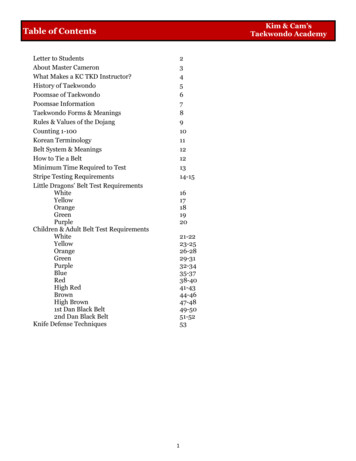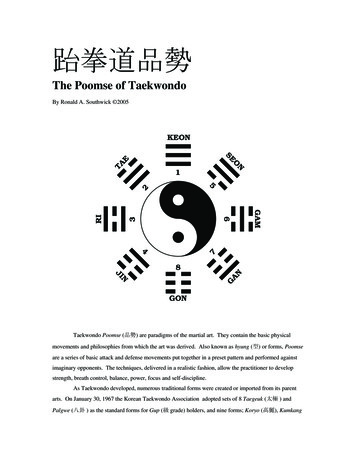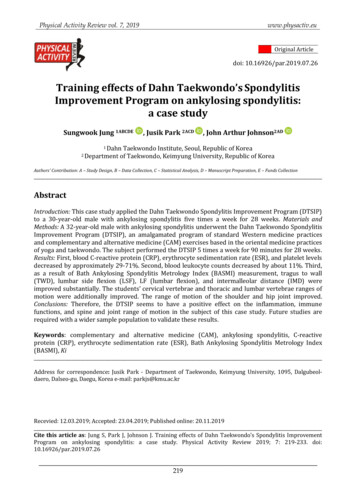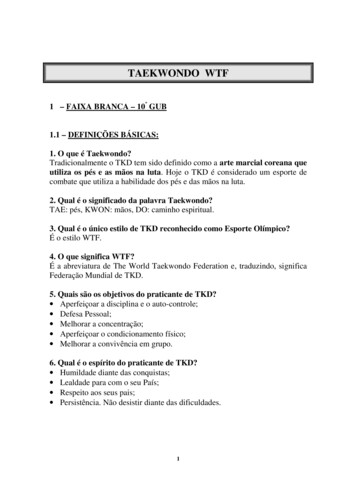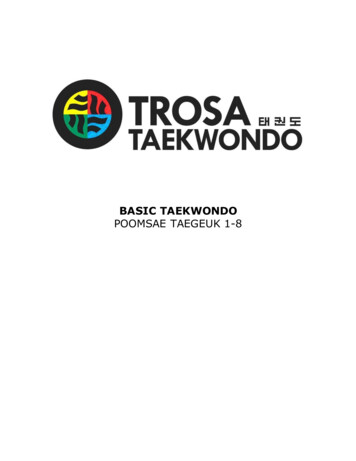
Transcription
BASIC TAEKWONDOPOOMSAE TAEGEUK 1-8
Meaning of the symbol TaegeukTaegeuk is a symbol representing the principles of the cosmos creation and thenorms of human life. The circumference of the Taegeuk mark symbolizes infinity andthe two parts, red and blue, inside the circle symbolize yin (negative) and yang(positive), which look like rotating all the time. Therefore, Taegeuk is the light whichis the unified core of the cosmos and human life and its boundlessness signifiesenergy and the source of life. The yin and yang represents the development of thecosmos and human life and the oneness of symmetrical halves, such as negative andpositive, hardness and softness, and materials and anti-materials.The eight bar-signs (called kwae) outside the circle are so arranged to go along withthe Taegeuk in an orderly system. One bar means the yang and two bars the yin,both representing the creation of harmonization with the basic principles of allcosmos phenomena. The Taegeuk, infinity and yin-yang are the three elementsconstituting the philosophical trinity as mentioned in the Samil Sinko, the Scriptureof Korean race.
The Origin of Taegeuk DenominationAccording to the old book of history, Sinsi Bonki, around (B.C.35), a son of the 5themperor of the Hwan-ung Dynasty in on ancient nation of the Tongyi race whosename was Pokhui, was said to have received the Heaven's ordinance to have aninsight in the universal truths, thereby observing rituals for the Heaven and finallyreceiving the eight kwaes (bar signs). After all, this has been passed down through along, long history by King Mun, Chou tsu, Confucius and Scholar Kim Il bu, alldescendants of the Tongyi race. Scholar Kim finally completed the present Taegeukmark.PoomsaeThe Taegeuk poomsae was established on the basis of profound philosophy ofTaegeuk to be trained by the Taekwondo beginners. Its poomsae line and seogi arebased on the invariable basic thought of Taekwondo. The monism of Taegeuk is theframe of this poomsae, each Kwae being reflected in a pattern of Taegeuk poomsae,which elucidates the Taekwondo spirit and the profoundness of Taekwondotechniques.The Origin of PoomsaeThe Taekwondo poomsaes are so designed to cope collectively with the outsidethreats in that society has already developed into an organized group, weakening thenecessity of solitary individual defense measures. For the constituents of community,the practice and transmission of techniques should be convenient and lesscomplicated. In that sense, the poomsae has been gradually systematized throughpractical experiences togther with the help of philosophical and medical sciences.It is believed that in ancient times the poomsae was practiced among the ruling classand the first poomsae pattern appearing in the documents or monuments wasaround the first century, when Koguryo reined the Han (Korean) race.Definition of PoomsaeEach poom of the poomsae has been inherited through a long history of about 5,000years, finally as a product of scientific technique formulated on the basis of thetraditional national spirit and practical experiments. From the technical viewpoint,the poomsae itself is Taekwondo, and the basic movements are no more than thepreliminary actions to reach the poomsae. The Kyorugi is a practical application ofthe poomsae and the Taekwondo spirit is manifested not in an abstract mentalphilosophy expressed in the documents but in the actions of poomsae. Then, what isthe Taekwondo poomsae? The poomsae is the style of conduct which expressesdirectly or indirectly mental and physical refinements as well as the principles ofoffense and defense resulting from cultivation of Taekwondo spirit and techniques.Significance of PoomsaeThe poomsae is a series of movements for offense and defense techniques which canbe practiced and trained, even without presence of an instructor, in accordance withthe fixed patterns. Therefore, the poomsae has the merits, by its practice, to makethe trainee enhance the Kyorugi techniques and applied techniques including specialtechniques which can hardly be practiced by the training of each separate basicmovement alone.
The poomsae can be trained along the imaginary or drawn poomsae line, whichmarks the position of foot and the line direction to move along.Considerations for Training PoomsaeThe poomsae is a series of alternate attack and defense actions : therefore, thereare frequent changes of actions and connections of techniques. One must payattention to the movement of body, eyes, respiration, etc. The steps of payingattention are as follow:1) A complete understanding of the significance of poomsae and the principles of itscomposition.2) A perfect memorization of the poomsae line, movements and direction.3) During the practice, the following must be taken into consideration :1.2.3.4.5. The eyesMovement of the center of balanceLow or high speedStrong or weak forceRespirationTraining of PoomsaeA completion of poomsae can be achieved through hard training following the 5 steps:1. PatternThe first step of training poomsae is to learn the pattern. Concentration ofspirit, eyes, and angles of movements must be emphasized in addition to theaccuracy of actions.2. SignificanceIn the next step, the emphasis must be laid on the balance, strength andweakness, low or high speed, respiration and poomsae line. The significanceof movements, connection of pooms and the complete poomsae must belearned correctly.3. Practical UseOne must adapt what he has learned to his practical use, finding out thepracticability.4. Self StyleOne must evaluate his findings about the effectiveness of what he haslearned, comparing with his bodily structure, speed, strength, musclestrength, impulsive power, points of emphasis in training, etc., and moderatethe techniques into his own style.
Categories of PoomsaeThe poomsae are categorized by the technique, composition and points of stress,which are classified each into 3 minor breakdowns.1. TechniqueThe technique means the technical patterns of the entire poomsae. Theessence of Taekwondo is the martial art; therefore, the categorization ofpracticable patterns of techniques is important.1. Poomsae containing various techniquesThis contains more techniques of chagi and makki than are neededfor practical use. Practicable techniques must be selected amongthem in the course of training.2. Poomsae containing practicable techniquesThis includes practically used techniques only, which are classifiedinto a series of chigi techniques, a series of makki techniques and abalanced combination of chigi and makki techniques.3. Poomsae containing simple techniquesThis is classified into the basic course and the advanced course, inthe advanced course, the training of cultivating the inner strength ofbody by means of controlling the respiration is included. Thevariations of techniques should be mastered through hard training.2. CompositionThe composition of poomsae movements is differentiated according to theproportion of poom and technique, hand techniques and foot techniques, andseogi and its moving directions. Except for certain special cases, the poomsaemovements are equally distributed among all parts of the body symmetricallybetween fore and back and between left and right. Therefore, the proportionof foot techniques and hand techniques is the criteria to decide thecomposition of poomsae movements.1. Poomsae with the priority on hand techniques2. Poomsae with the priority on foot techniques3. Poomsae in which hand techniques and foot techniques are evenlydistributed.3. Points of StressThe poomsae is also classified by the extent of emphasis in favor of eitherstrength or softness and of either a slow movement or a fast movement.
Strong but slow movements and speedy but soft movements are included inthe similar categories.1. Strong but slow poomsae2. Weak but speedy poomsae3. Poomsae well balanced in strength and weakness as well as inslowness and speediness.4. However, the above methods of categorization are not absolute for theadvanced course of training.Classification of PoomsaeTaegeuk poomsaes from 1(il) jang to 8(pal) jang are classified as Kup grader'spoomsaes and the poomsaes from Koryo up to Ilyo as Dan-grader's, i.e., blackbelter's poomsaes. The poomsaes consists of basic movements and poom and theyare so arranged to fit the frame of movement direction, which is called the poomsaeline. The poomsae lines are described after symbols or Chinese characters.Types of Poomsae Lines Taegeuk poomsae (1-8)This consists of 8 patterns symbolizing the 8 divination signs(bars) in the Orientalscience of divination, and it is generally expressed by the Chinese character,meaning a king. Koryo poomsaethe shape of the Chinese character, meaning a learned man. Keumgang poomsaethe Chinese character, meaning a mountain (Mt. Diamond) Taebaek poomsaethe Chinese character, meaning an artisan. Pyongwon poomsaethe Chinese character, meaning one. Sipjin poomsaethe Chinese character, meaning ten. Jitae poomsaethe shape of a Korean vowel, sounding "oh" Chonkwon poomsaethe shape of a Korean vowel, sounding "wu" Hansu poomsaethe Chinese character, meaning water. Ilyo poomsaethe shape of a reversed swastika sign.
Symbols Expressing the Direction of Poomsae LinesFor the diagrammatical description of each poomsae line, some phonetic symbols ofthe Korean alphabet are used to mark the position of the trainee who exercises apoomsae practice.Na : always the starting point of each poomsae.Ga : the forward direction of preceeding.Da : the left side from the starting point.Ra : the right side from the starting point.Ma : the backward direction from the starting point.Taegeuk Ill Jang (1)Taegeuk 1 Jang represents the symbol of “Keon”, one of the 8 Kwaes (divinationsigns), which means the heaven and “yang”. As the “Keon” symbolize s the beginningof the creation of all things in the universe, so does the Taegeuk 1 jang in thetraining of Taekwondo. This poomsae is charaterized by its easiness in practicing,largely consisting of walking and basic actions, such as arae-makki, momtongmakki, momtong-jireugi and ap-chagi. The 8th Kup-grade trainees practice thispoomsae.
JunbiGaNanaranhiseogi-kibon junbiseogi1Da1Da1wen apseogiput forth(foot)araemakki2Da1Da1oreun apseogiput forth(foot)momtong bandaejireugi3Ra1Ra1oreun apseogiturn aroundaraemakki4Ra1Ra1wen apseogiput forth(foot)momtong bandaejireugi5GaGawen apkubiturnaraemakki6GaGawen apkubithe same stancemomtong bandaejireugi7Ra2Ra2oreun apseogimove and step downmomtong anmakki8Ra2Ra2wen apseogiput forth(foot)momtong bandaejireugi9Da2Da2wen apseogiturn aroundmomtong anmakki10Da2Da2oreun apseogiput forth(foot)momtong bandaejireugi11GaGaoreun apkubiiturnaraemakki12GaGaoreun apkubiithe same stancemomtong barojireugi13Da3Da3wen apseogimove and step downolgulmakki14Da3Da3oreun apseogi15Ra3Ra3oreun apseogi16Ra3Ra3wen apseogi17NaNawen apkubimove and step down18NaNaoreun apkubiiput forth(foot)BaroGaNanaranhiseogi pull left foot, turn leftwardright foot apchagi,step downturn aroundleft foot apchagi,step downmomtong bandaejireugiolgulmakkimomtong bandaejireugiaraemakkimomtong bandaejireugi "kihap"kibon junbiseogi
Taegeuk Ii Jang (2)Taegeuk 2 Jang symbolizes the "Tae", one of the 8 divination signs, which signifiesthe inner firmness and the outer softness. An introduction of the olguljireugi is anew development of Taegeuk poomsae. The apchagi actions appear more frequentlythan in Taegeuk 1 Jang. The 7th Kup-grade trainees practice this poomsae.
JunbiGaNanaranhiseogi-kibon junbiseogi1Da1Da1wen apseogiput forth(foot)araemakki2Da1Da1oreun apkubiiput forth(foot)momtong bandaejireugi3Ra1Ra1oreun apseogiturn aroundaraemakki4Ra1Ra1wen apkubiput forth(foot)momtong bandaejireugi5GaGawen apseogiturnmomtong anmakki6GaGaoreun apseogiput forth(foot)momtong anmakki7Da2Da2wen apseogimove and step downaraemakki8Da2Da2oreun apkubii9Ra2Ra2oreun apseogiturn aroundaraemakki10Ra2Ra2wen apkubileft foot apchagi, step downolgul bandaejireugi11GaGawen apseogiturnolgulmakki12GaGaoreun apseogiput forth(foot)olgulmakki13Ra2Ra2wen apseogiturnmomtong anmakki14Da3Da3oreun apseogi15NaNawen apseogi16NaNaoreun apseogi17NaNawen apseogi18NaNaoreun apseogiBaroGaNanaranhiseogiright foot apchagi,step downfeet remain,change directionmove and step downright foot apchagi,step downleft foot apchagi, step downright foot apchagi,step downpull left foot,turn leftwardolgul bandaejireugimomtong anmakkiaraemakkimomtong bandaejireugimomtong bandaejireugimomtong bandaejireugi "kihap"kibon junbiseogi
Taegeuk Sam Jang (3)Taegeuk 3 Jang symbolizes the "Ree", one of the 8 divination signs, which represents"hot and bright". This is to encourage the trainees to harbor a sense of justice andardor for training. A successful accomplishment of this poomsae will give the trainee sa promotion to a blue belter. New actions are sonnal mokchigi, sonnal makki andthe dwitkubi stance. This poomsae is characterized by successive makki andjireugi, chagi and continued jireugi. Emphasis is laid on the counterattacks againstthe opponent's attack. The 6th Kup-grade trainees can practice this poomsae.
JunbiGaNanaranhiseogi-kibon junbiseogi1Da1Da1wen apseogiput forth(foot)araemakki2Da1Da1oreun apkubii3Ra1Ra1oreun apseogiturn aroundaraemakki4Ra1Ra1wen apkubileft foot apchagi, step downmomtong dubeonjireugi5GaGawen apseogiturnhansonnal mokchigi6GaGaoreun apseogiput forth(foot)hansonnal mokchigi7Da2Da2oreun dwitkubileft foot move andhansonnal momtongstep downbakkatmakki8Da2Da2wen apkubiwen apkubimomtong barojireugi9Ra2Ra2wen dwitkubiright foot slightly pulled in10Ra2Ra2oreun apkubi11GaGawen apseogimove and step downmomtong anmakki12GaGaoreun apseogiput forth(foot)momtong anmakki13Ra3Ra3wen apseogiturnaraemakki14Ra3Ra3oreun apkubii15Da3Da3oreun apseogiturn aroundaraemakki16Da3Da3wen apkubileft foot apchagi, step downmomtong dubeonjireugi17NaNawen apseogiturn, araemakkimomtong barojireugi18NaNaoreun apseogiput forth, araemakkimomtong barojireugi19NaNawen apseogi20NaNaoreun apseogiBaroGaNanaranhiseogiright foot apchagi,step downright foot slightlypushed forwardright foot apchagi,step downleft foot apchagi, step down& arae-makkiright foot apchagi, step down& arae-makkipull left foot,turn leftwardmomtong dubeonjireugihansonnal momtongbakkatmakkimomtong barojireugimomtong dubeonjireugimomtong barojireugimomtong barojireugi "Kihap"kibon junbiseogi
Taegeuk Sa Jang (4)Taegeuk 4 Jang symbolizes the "Jin", one of the 8 divination signs, which representsthe thunder meaning great power and dignity. New techniques are sonnalmomtongmakki, pyonsonkkeuttzireugi, jebipoom mokchigi, yopchagi,momtong bakkatmakki, deungjumeok olgulapchigi. It is characterized byvarious movements in preparation for the kyorugi and lots of dwitkubi seogi cases.The 5th Kup-grade trainees practice this poomsae.
JunbiGaNanaranhiseogi-kibon junbiseogi1Da1Da1oreun dwitkubiput forth(foot)sonnal momtongmakki2Da1Da1oreun apkubiiput forth(foot)pyonsonkkeut sewotzireugi3Ra1Ra1wen dwitkubiturn aroundsonnal momtongmakki4Ra1Ra1wen apkubiput forth(foot)pyonsonkkeut sewotzireugi5GaGawen apkubiturnjebi poom mokchigi6GaGaoreun apkubiiright foot apchagi,step downmomtong barojireugi7GaGaL.F. yopchagi,step down-8GaGawen dwitkubiR.F. yopchagi,step downsonnal momtongmakki9Ra3Ra3oreun dwitkubiturnmomtong bakkatmakki10Ra3Ra3oreun dwitkubiR.F. apchagi,place backmomtong anmakki11Da3Da3wen dwitkubifeet remain,change of directionmomtong bakkatmakki12Da3Da3wen dwitkubiL.F. apchagi,place backmomtong anmakki13NaNawen apkubimove and step downjebi poom mokchigi14NaNaoreun apkubiiright foot apchagi,step downdeungjumeok olgul apchigi15Ra2Ra2wen apseogimove and step downmomtongmakki (trunk blocking)16Ra2Ra2wen apseogifeet remain,the same stancemomtong barojireugi17Da2Da2oreun apseogifeet remain,change of directionmomtongmakki (trunk blocking)18Da2Da2oreun apseogifeet remain,the same stancemomtong barojireugi19NaNawen apkubimove to step down(momtongmakki)momtong dubeonjireugi20NaNaoreun apkubiput forth (foot),(momtongmakki)momtong dubeonjireugiBaroGaNanaranhiseogiL.F. pulled toturn leftwardkibon junbiseogi
Taegeuk Oh Jang (5)Taegeuk 5 Jang symbolizes the "Son", one of the 8 divination signs, whichrepresents the wind, meaning both mighty force and calmness according to itsstrength and weakness. New movements are mejumeok naeryochigi, palkupdollyo-chigi, palkup pyojeokchigi and such stances as kkoaseogi, wenseogiand oreunseogi. This is characterized by the successive makki such as araemakkiand momtongmakki and also the chigi by tumbling after jumping. The 4th Kup gradetrainees practice this poomsae.
JunbiGaNanaranhiseogi-kibon junbiseogi1Da1Da1wen apkubiput forth(foot)araemakki2Da1Da1wen seogiretrieve footmejumeok naeryochigi3Ra1Ra1oreun apkubiichange of direction,put forth footaraemakki4Ra1Ra1oreun seogiretrieve footmejumeok naeryochigi5GaGawen apkubiput forth foot, momtongmakkimomtong anmakki6GaGaoreun apkubiiR.F. apchagi, put forth,deungjumeok apchigimomtong anmakki7GaGawen apkubiL.F. apchagi, put forth,deungjumeok apchigimomtong anmakki8GaGaoreun apkubiiput forth(foot)deungjumeok apchigi9Ra2Ra2oreun dwitkubiturnhansonnal bakkatmakki10Ra2Ra2oreun apkubiiput forth(foot)palkup dollyochigi11Da3Da3wen dwitkubiturn aroundhansonnal bakkatmakki12Da3Da3wen apkubiput forth(foot)palkup dollyochigi13NaNawen apkubiturn, araemakkimomtong anmakki14NaNaoreun apkubiiright foot apchagi, step down& arae-makkimomtong anmakki15Ra2Ra2wen apkubimove and step downolgulmakki16Ra2Ra2oreun apkubiiR.F. yopchagi,step downpalkup pyojeokchigi17Da2Da2oreun apkubiturn aroundolgulmakki18Da2Da2wen apkubiL.F. yopchagi,put forthpalkup pyojeokchigi19NaNawen apkubiturn, araemakkimomtong anmakki20NaNadwikkoaseogiright foot apchagi,step downmomtong dubeonjireugi "Kihap"BaroGaNanaranhiseogiturn leftwardkibon junbiseogi
Taegeuk Yuk Jang (6)Taegeuk 6 Jang symbolizes the "Kam", one of the 8 divination signs, whichrepresents water, meaning incessant flow and softness. New movements arehansonnal olgul bitureo makki, dollyo-chagi, olgul bakkat-makki, arae hechomakki, and batangson momtong-makki. One should be careful to make thekicking foot land on the ground correctly after dollyo-chagi and to lower the hand bya palm's length at the time of delivering a batangson momtong- makki lower than inthe palmok-makki. This is practiced by the 3rd Kup-graders.
JunbiGaNanaranhiseogi-kibon junbiseogi1Da1Da1wen apkubiput forth(foot)araemakki2Da1Da1oreun dwitkubiR.F. apchagi,retrieve footmomtong bakkatmakki3Ra1Ra1oreun apkubiichange direction, R.F.slightly put forwardaraemakki4Ra1Ra1wen apkubiapchagi,retrieve footmomtong bakkatmakki5GaGawen apkubiturnhansonnal olgul bitureomakki6Da2Da2wen apkubiR.F. dollyochagi, L.F. putforth, olgul bakkatmakkimomtong barojireugi7Da2Da2oreun apkubiiright foot apchagi,step downmomtong barojireugi8Ra2Ra2oreun apkubiiturn around,olgul bakkatmakkimomtong barojireugi9Ra2Ra2wen apkubileft foot apchagi, step downmomtong barojireugi10GaGanaranhiseogiL.F. move to steparae hechomakki11GaGaoreun apkubiiput forth(foot)hansonnal olgul bitureomakki12Da3Da3oreun apkubiiL.F. dollyochagi, "kihap",R.F. move "Da 3" line, turnaraemakki13Da3Da3wen dwitkubiL.F. apchagi,retrieve footmomtong bakkatmakki14Ra3Ra3wen apkubiL.F. slightly forth afterchange directionaraemakki15Ra3Ra3oreun dwitkubiR.F. apchagi,retrieve footmomtong bakkatmakki16GaNaoreun dwitkubiR.F. move to stepsonnal momtongmakki17GaNawen dwitkubiL.F. retrieve to step downsonnal momtongmakki18GaNawen apkubiR.F. retrieve, batangsonmomtongmakkimomtong barojireugi19GaNaoreun apkubiiR.F. pull backmomtong barojireugiBaroGaNanaranhiseogiturn leftwardkibon junbiseogi
Taegeuk Chil Jang (7)Taegeuk 7 Jang symbolizes the "Kan", one of the 8 divination signs, whichrepresents the mountain, meaning ponderosity and firmness. New movements aresonnal araemakki, batangson kodureomakki, bojumeok kawimakki,mureupchigi, momtong hechomakki, dujumeok jeocho jireugi, arae otkoreomakki, deungjumeok bakkat chigi, pyojeok-chagi, yop-jireugi and suchstances as beomseogi and juchumseogi. Smooth connection of movement isimportant for training. The 2nd Kup-graders practice this poomsae.
JunbiGaNanaranhiseogikibon junbiseogi1Da1Da1wen beomseogiL.F. put forthbatangson momtong anmakki2Da1Da1wen beomseogiR.F. apchagi,place backmomtongmakki3Ra1Ra1oreun beomseogifeet remain,change of directionbatangson momtong anmakki4Ra1Ra1oreun beomseogiL.F. apchagi, retrievemomtongmakki5GaGaoreun dwitkubiturnsonnal araemakki6GaGawen dwitkubiput forth(foot)sonnal araemakki7Da2Da2wen beomseogimove and step downbatangson momtong kodureo anmakki8Da2Da2wen beomseogifeet remain, same stancedeungjumeok olgulapchigi9Ra2Ra2oreun beomseogichange directionbatangson momtong kodureo anmakki10Ra2Ra2oreun beomseogifeet remain,the same stancedeungjumeok olgulapchigi11GaGamoaseogiL.F. pull to modumbalbojumeok12GaGawen apkubiput forth, bandae kawimakkikawimakki13GaGaoreun apkubiiput forth, bandae kawimakkikawimakki14Ra3Ra3wen apkubiturnmomtong hechomakki15Ra3Ra3dwikkoaseogiL.F. retrievejeochojireugi16Ra2Ra3oreun apkubiiL.F. retrievearae otgoreo makki17Da3Da3oreun apkubiiturn aroundmomtong hechomakki18Da3Da3dwikkoaseogimureupchigi, L.F. jump forthjeochojireugi19Da3Da3wen apkubiR.F. retrievearae otgoreo makki20NaNawen apseogiturndeungjumeok bakkatchigi21NaNajuchumseogiR.F. pyojeokchagi, put forthpalkup pyojeokchigi22NaNaoreun apseogibody raise, L.F. pulle slightlydeungjumeok bakkatchigi23NaNajuchumseogiL.F. pyojeokchagi, put forthpalkup pyojeokchigi24NaNajuchumseogifeet remainhansonnal yopmakki25NaNajuchumseogiR.F. put forthmomtong yopjireugi, "kihap"BaroGaNanaranhiseogipull left foot,turn leftwardkibon junbiseogi
Taegeuk Pal Jang (8)Taegeuk 8 Jang symbolizes the "Kon", one of the 8 divination signs, whichrepresents "Yin" and earth, meaning the root and settlement and also the beginingand the end. This is the last of the 8 Taegeuk poomsaes, which may enable thetrainees to undergo the Dan (black belt) promotion test. New movements are dubaldangseong apchagi, momtong kodureo bakkatmakki, arae kodureo makki,twiochagi, and palkup dollyochigi. Emphasis must be laid on the accuracy ofstepping and the difference between jumping-over kick and dubal-dangsong(alternate jumping kick in the air). The 1st Kup-grade trainees practice thispoomsae.
Junbi GaNanaranhiseogikibon junbiseogi1GaGaoreun dwitkubiL.F. put forthkodureo bakkatmakki2GaGawen apkubisame positionmomtong barojireugi3GaGawen apkubitwo feet dangseong apchagi, "kihap", footforth, momtong makkimomtong dubeonjireugi4GaGaoreun apkubiiR.F. put forthmomtong bandaejireugi5Ra3Ra3oreun apkubiiturn, L.F. movedto step downwesanteulmakki6Ra3Ra3wen apkubifeet remain, center of mas movedangkyo teokjireugi7Da3Da3wen apkubiL.F. apkkoaseogi, R.F. put forthwesanteulmakki8Da3Da3oreun apkubiifeet remain, center of mas movedangkyo teokjireugi9GaNaoreun dwitkubiR.F. move to stepsonnalmakki10GaNawen apkubifeet remainmomtong barojireugi11GaNaoreunbeomseogiR.F. apchagi, foot retrieve,L.F. one step backwardbatangson momtongmakki12Da2Da2 wen beomseogiL.F. move to stepsonnalmakki13Da2Da2L.F. apchagi, put forthmomtong bandaejireugi14Da2Da2 wen beomseogiL.F. pullbatangson momtongmakki15Da2Ra2oreunbeomseogichange directionsonnal momtongmakki16Ra2Ra2oreun apkubiileft foot apchagi,step downmomtong barojireugi17Ra2Ra2oreunbeomseogiR.F. pullbatangson momtongmakki18NaNawen dwitkubiturnarae kodureo makki19NaNaoreun apkubiiL.F. apchagi, R.F. jumpapchagi, "kihap", put forthmomtong dubeonjireugi20Da1Da1oreun dwitkubiturnhansonnal momtongbakkatmakki21Da1Da1wen apkubiR.F. remains, L.F. push forthoreunpalkup dollyochigi22Da1Da1wen apkubisame position, stancedeungjumeok apchigi23Da1Da1wen apkubisame position, stancemomtong bandaejireugi24Ra1Ra1wen dwitkubichange directionhansonnal momtongbakkatmakki25Ra1Ra1oreun apkubiiL.F. remains, R.F. push forthwenpalkup dollyochigiwen apkubi
26Ra1Ra1oreun apkubiisame position, stancedeungjumeok apchigi27Ra1Ra1oreun apkubiisame position, stancemomtong bandaejireugiBaroGaNanaranhiseogiL.F. pullkibon junbiseogi
Taegeuk to be trained by the Taekwondo beginners. Its poomsae line and seogi are based on the invariable basic thought of Taekwondo. The monism of Taegeuk is the frame of this poomsae, each Kwae being reflected in a pattern of Taegeuk poomsae, which elucidates the Taekwondo spirit and the profoundness of Taekwondo techniques. The Origin of PoomsaeFile Size: 892KB



